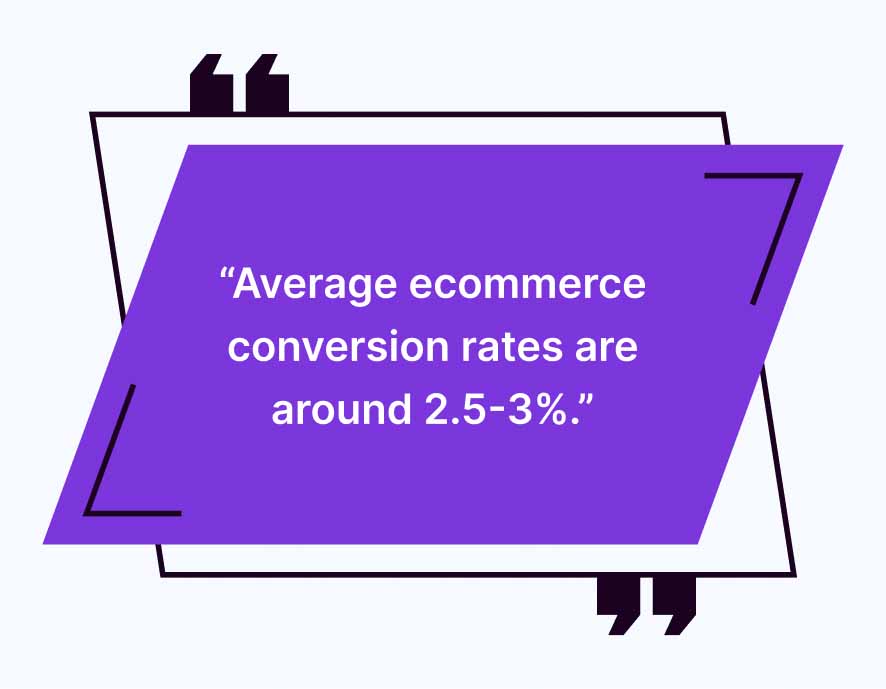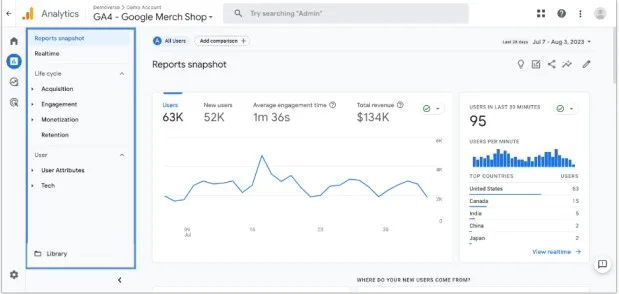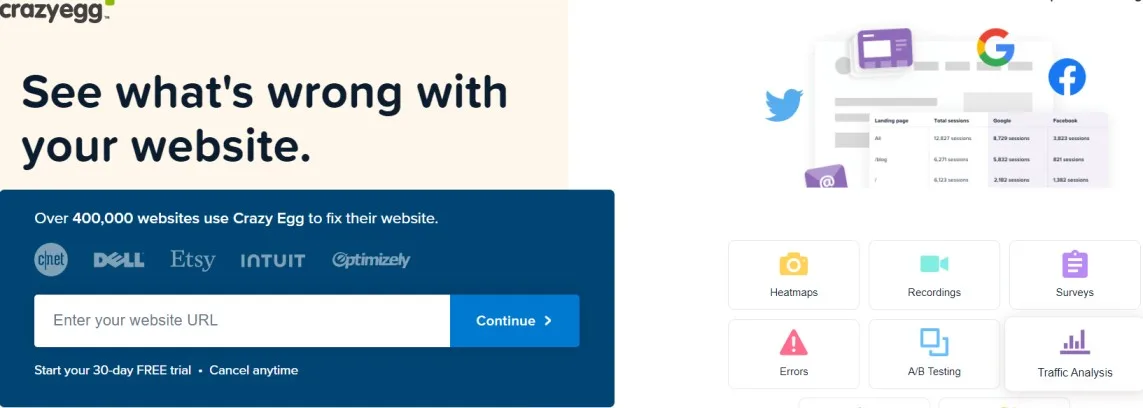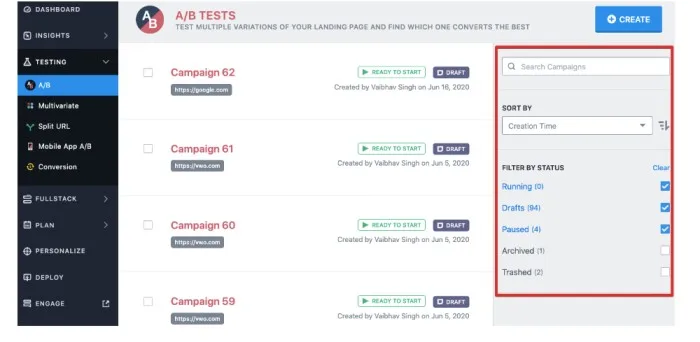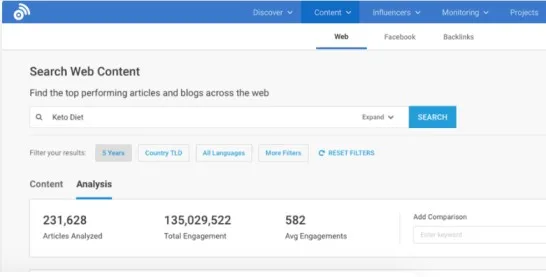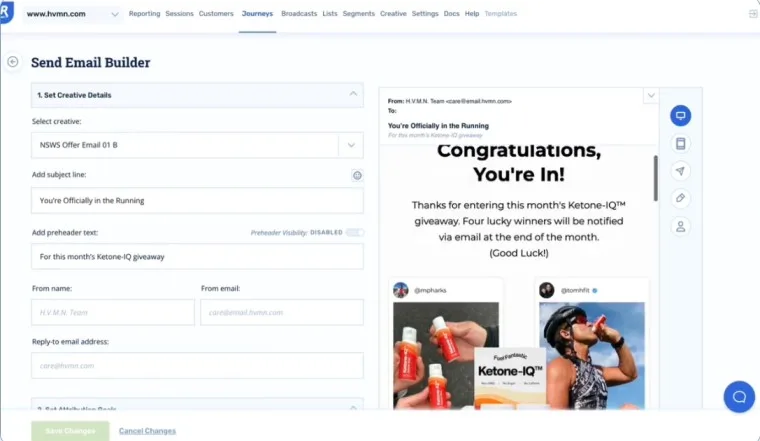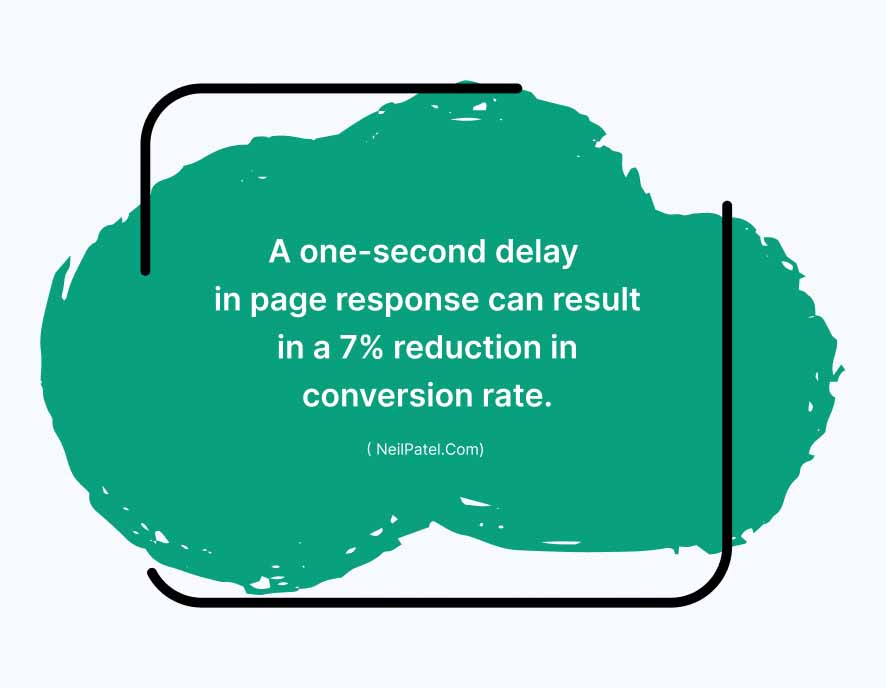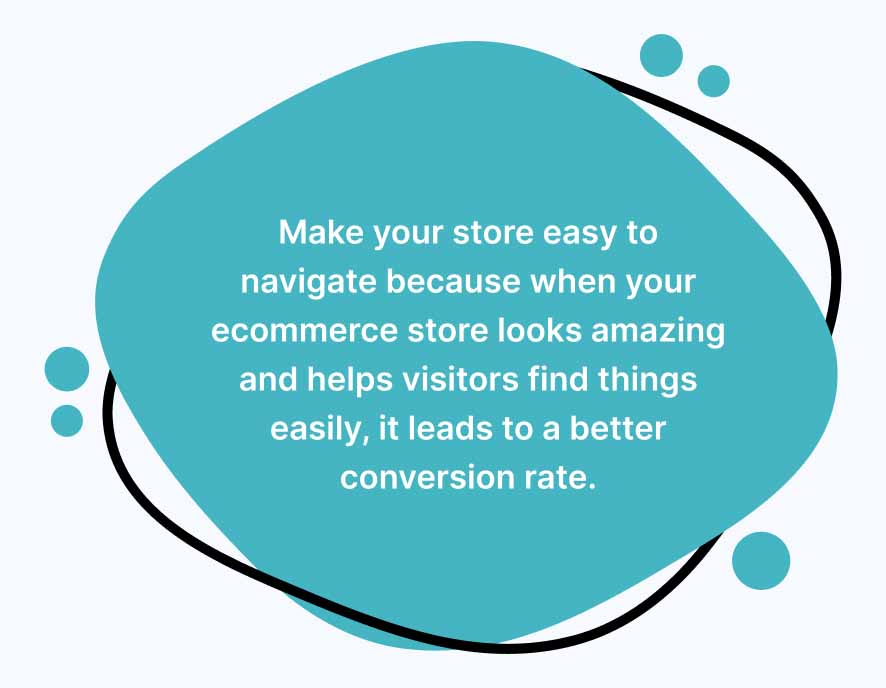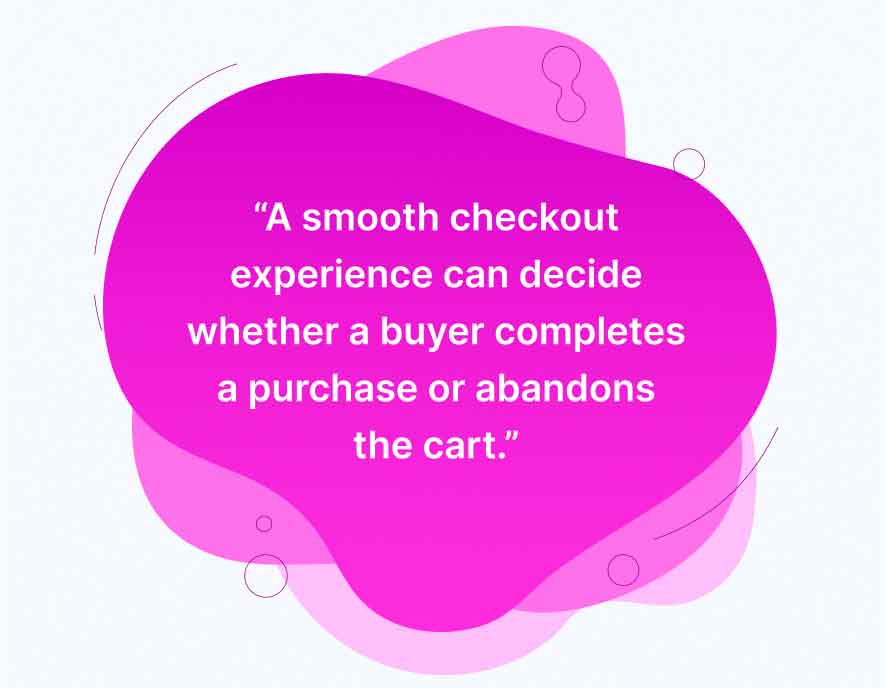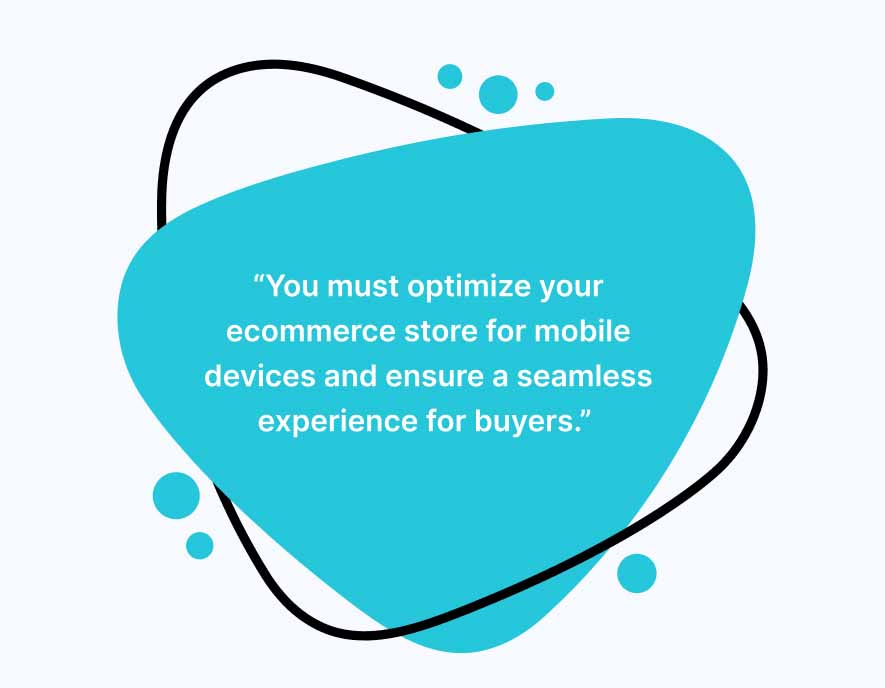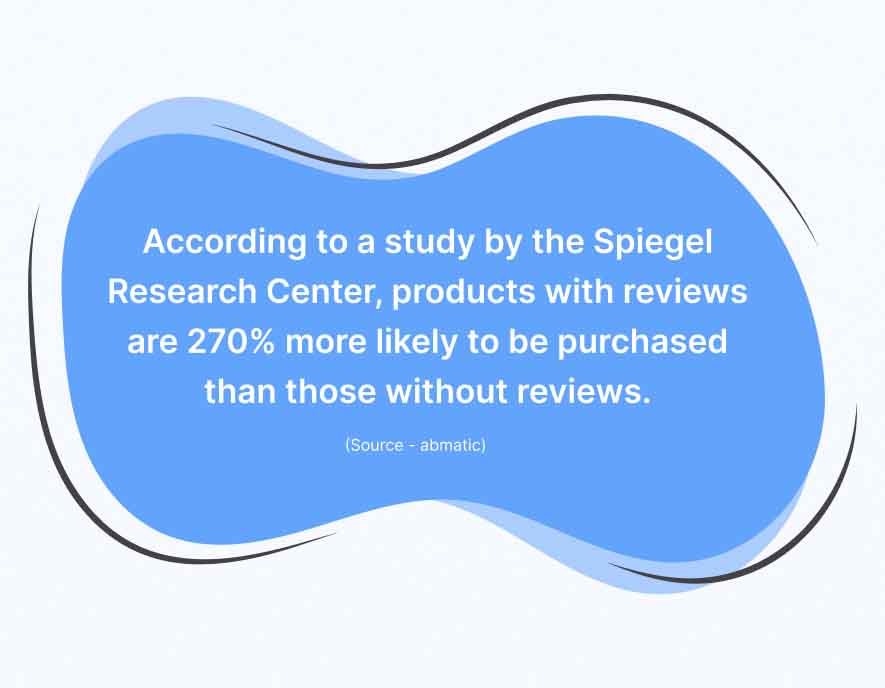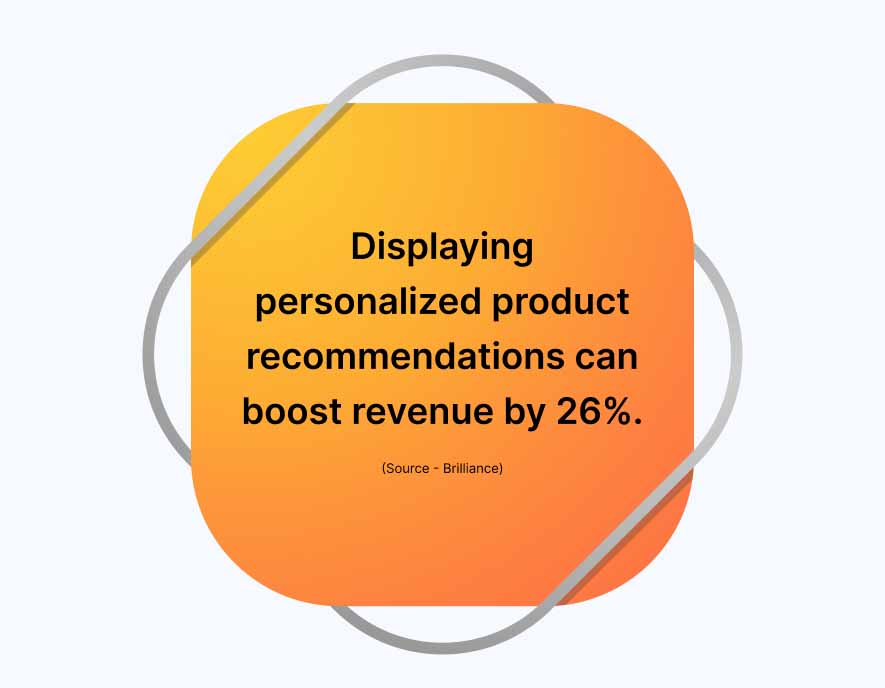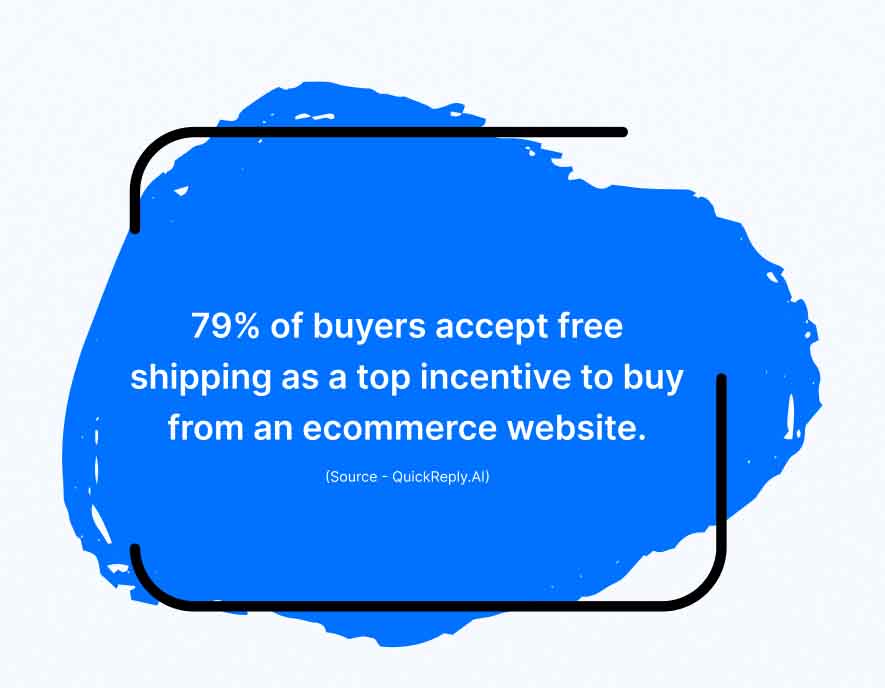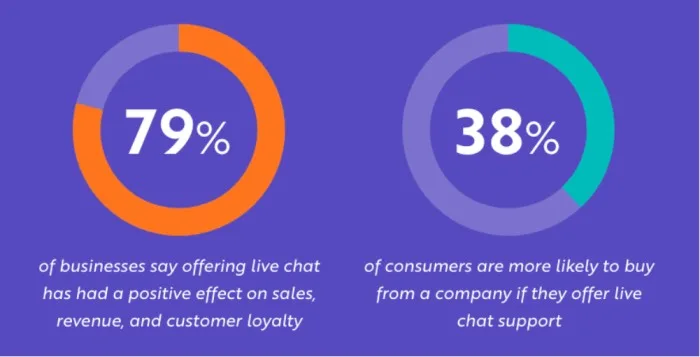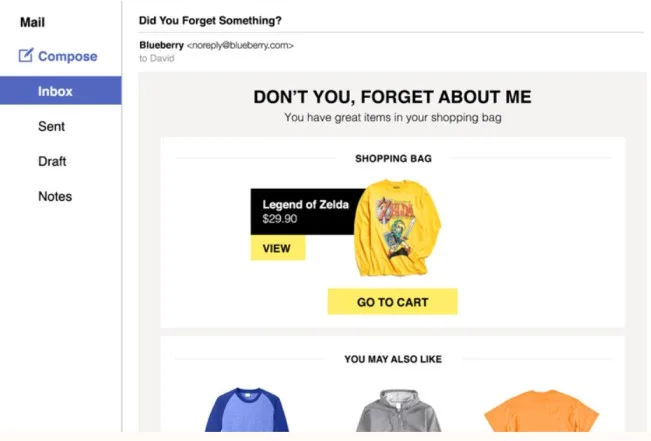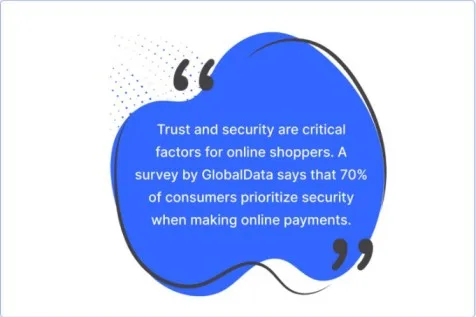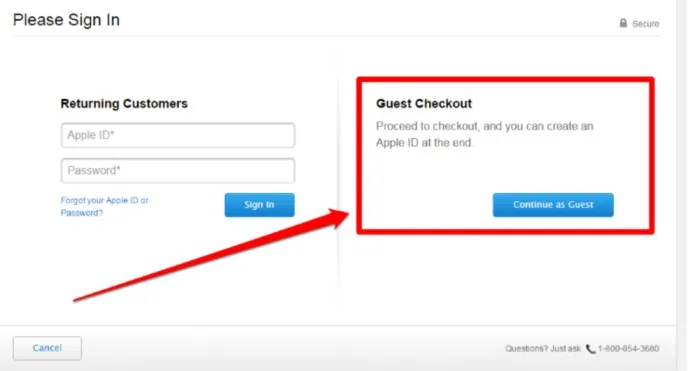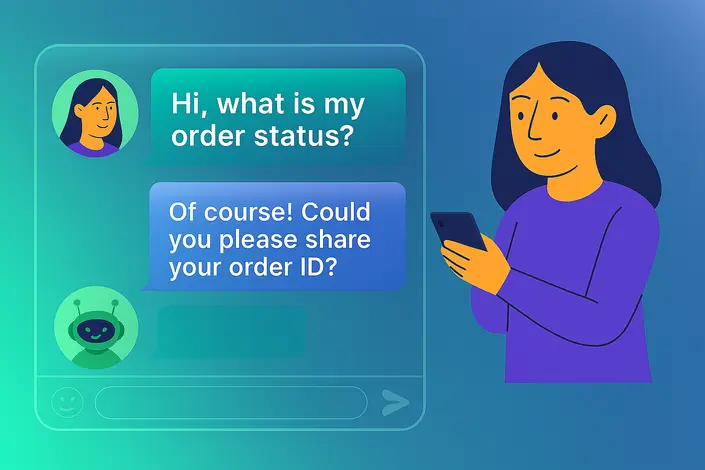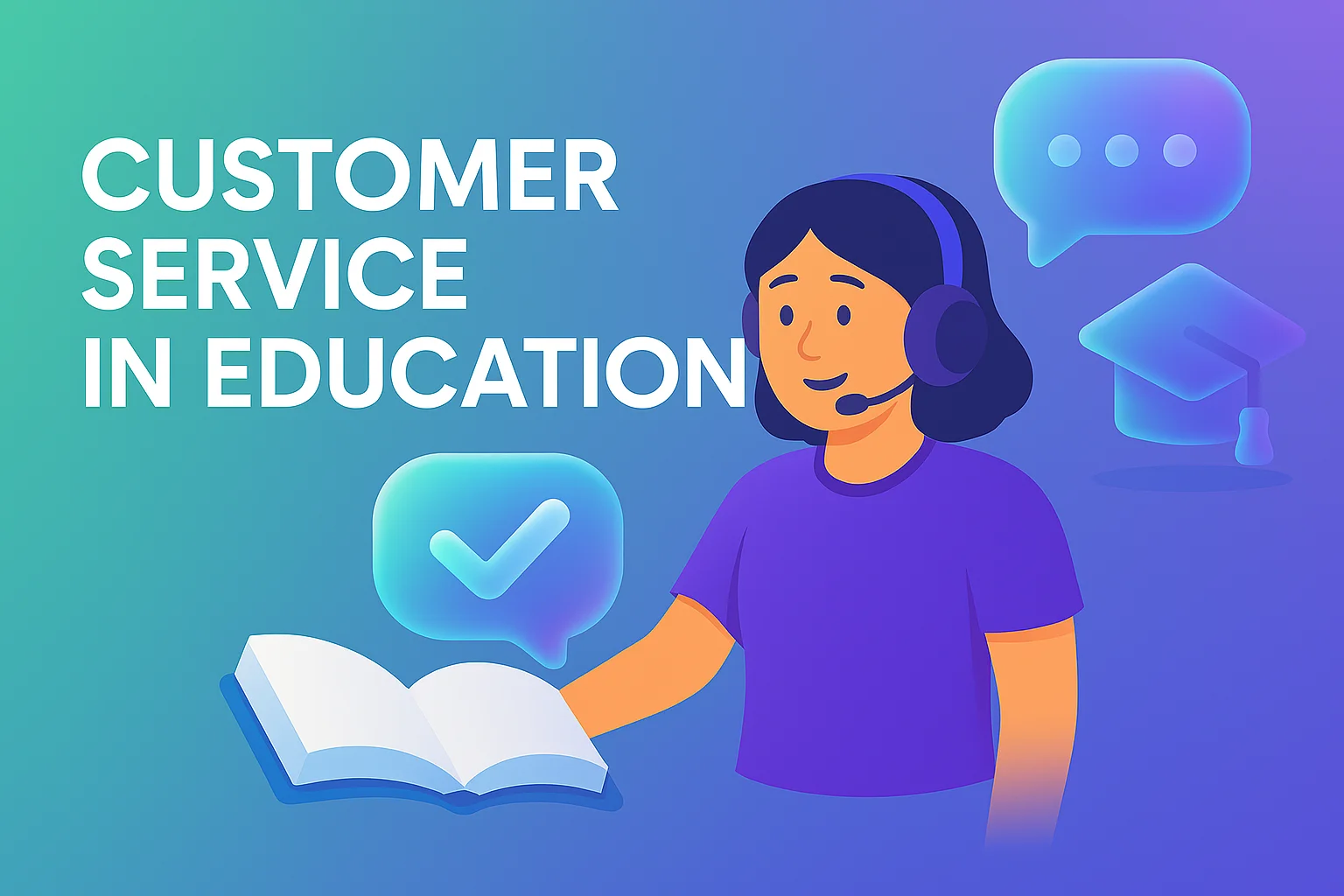How to Increase Ecommerce Conversion Rate (Tips & Best Practices)
- December 19, 2023
- 29 mins read
- Listen

Has your ecommerce site faced low conversion rates despite a good traffic flow?
Oops! What next then?
Well, it’s time to learn how to increase your ecommerce conversion rate. After all, what’s the purpose of getting a decent stream of traffic on your site when you can’t convert most of them?
Successful online stores are often those that convert a good percentage of its visitors into paying customers. This ensures more revenue and more profit for the business.
The good thing is, that boosting your ecommerce conversion rate is not a huge challenge – it’s very much achievable if you’re ready to implement strategic changes and optimize a few key aspects of your website.
At the same time, you should understand how the vast majority of a site’s visitors tend to leave without buying anything at all. You should also know how the average conversion rate for e-commerce stores stands between 2 to 3%.
But worry not, as this blog has it all covered – it will discuss what conversion is in ecommerce, how to calculate it, and how to increase it.
Before diving deep, we will first understand what the conversion rate in ecommerce is…
What is Conversion in Ecommerce?
Conversion in e-commerce refers to a specific action you want visitors to take on your website. In most cases, this “specific action” is making a purchase, but sometimes it could also mean other things as well. For example, conversion may also refer to signing up for a newsletter, downloading an e-book, filling out a contact form, or any other action your ecommerce website targets as a goal.
Let’s understand with a real-life example. Suppose you run an online store selling mobiles and smartphones. In this case, a successful conversion will happen when a visitor browses through your products, selects a smartphone, adds it to the cart, moves to the checkout, and ultimately buys it by filling in payment and shipping details.
For your e-commerce website, the conversion rate would represent the percentage of visitors who purchase out of the total number who visited the site.
In simple terms, conversion often aligns with the specific goals of the website or business. If a business is into subscription-based service, its conversion might also happen when someone signs up for a free trial and goes on to become a paying customer later on.
In essence, conversion represents the effectiveness of an ecommerce website in turning visitors into customers. A business must analyze and optimize the conversion rate as it has a direct impact on its overall performance, profit, and revenue.
What is a Good Conversion Rate for Ecommerce?
Do you know what is the industry standard conversion rate for eCommerce?
The average conversion rate for e-commerce websites stands between 2 to 3%, but this can fluctuate widely.
Multiple factors can impact the conversion rate of an ecommerce website and that’s why it varies. For your online store, the conversion rate would depend on the type of industry it operates in, product type, target audience, and the kind of marketing efforts it deploys.
While the average rate hangs around the 3% mark, some businesses with niche products or highly targeted audiences might achieve higher conversion rates as well. On the other hand, those with a broad range of products might have to contend with lower rates.
To understand what a good conversion rate for ecommerce is, you should also understand –
- A higher conversion rate is possible when you have a well-targeted audience
- A lower conversion rate happens when you have a less-defined audience
- Your store’s usability, design, and functionality can also impact the conversion rate
- Optimized websites tend to convert better
How to Measure Ecommerce Conversion Rate?
Measuring the ecommerce conversion rate is key to understanding the overall performance of your online store. It also helps you understand the effectiveness of your marketing efforts. Without measuring it, how can you know the areas of improvement?
Calculating the conversion rate in e-commerce is very straightforward. The formula is very simple and you just need to divide the number of conversions by the total visitors, and then multiply by 100 to get the conversion rate in percentage.
Let’s look at the formula to understand how are conversion rates measured –
“Conversion Rate = (Number of Conversions / Total Number of Visitors) x 100”
From the formula, it’s quite clear that there are a few steps to measure the conversion rate, including –
- You first need to track your website traffic and sales.
- You also need to know the number of visitors to your store over a specified period.
- You also need to count the total completed transactions/purchases for the mentioned period.
- You can now put the values in the formula and measure the conversion rate.
Let’s understand the ecommerce conversion rate formula with a real-life example –
Suppose your e-commerce website received 50,000 visitors last month. Out of those visitors, 1500 made a purchase. In this case,
- Conversion Rate = (1500 / 50,000) * 100
- Conversion Rate = 0.03 * 100
- Conversion Rate = 3%
In this case, your ecommerce website has a conversion rate of 3% for that particular month. In simple terms, out of every 100 visitors to your website, 3 converted into customers.
Here, the conversion rate is considered for sales. However, it could also be calculated for other specific goals as well. If your conversion is something other than sales, you’d take those actions into account and insert them into the formula accordingly.
Tools That Can Help Improve Ecommerce Conversion Rates
Are you looking for tools to better understand your ecommerce website performance and make data-driven decisions? Well, some really top-notch conversion rate optimization tools can add great value to your online business.
Let’s look at some of the tools to improve ecommerce conversion rates –
1. Web Analytics Tools
These tools are very effective in tracking, measuring, and reporting activities on your ecommerce website including clicks, traffic, and visit sources. Using web analytics tools can help you gain deep insights into what’s working and what is not on your website.
Let’s look at some popular web analytic tools –
Google Analytics
This tool is key to getting a complete understanding of your customers and their interactions with your business across devices and platforms. With Google Analytics, you will understand the customer journey in detail, resulting in improved website performance and marketing ROI.
Google Analytics is a top business intelligence tool that seamlessly integrates with Google Suites to map website performance. It does automatic data collection and creates website reports in Google Docs and Sheets.
From bounce rates to internal site searches, it gives insights into various aspects that have a big impact on conversion. It also allows businesses to create customized reports using their own metrics.
Crazy Egg
Crazy Egg is another popular web analytics tool to map customer interactions with your website. Unlike other tools in the category, its focus is on giving visual data of various things, including the traffic source and the best-performing areas of the website.
Crazy Egg is a wonderful tool for heat mapping as it can map customer workflow through several views. It also gives more in-depth data on customer interactions and website activity. Based on its features, you can make changes to your ecommerce website design and layout, resulting in improved conversion rates.
2. A/B Testing Tools
These tools are best used for comparing two versions of a website page or app against each other. Based on the testing, you can get a good idea of which web page or app performs better. Using A/B testing tools, you can determine which variation of your web page is better for the conversion goal you have in mind.
Let’s look at some popular A/B testing tools –
Optimizely
Optimizely is a popular A/B testing tool that businesses can use to optimize their websites and digital performances. It also has features for multivariate testing and personalization. The tool comes with a visual editor where marketers can build variations without any code. You can use its advanced targeting and segmentation tools to positively impact your website’s conversion rates.
VWO Testing
VWO Testing is an excellent A/B testing tool to optimize digital experiences and maximize conversions. The tool is key to analyze, optimize, and personalize websites, apps, and features. It helps you test anything and everything across your digital properties through features such as heat maps, form analytics, funnels, and visitor recordings. What’s more, you can also set up multivariate tests quickly without affecting the site’s speed.
3. On-site Conversion Tools
On-site conversion tools play an important role in optimizing the user experience and guiding visitors toward conversion. You can use them to boost your ecommerce website’s ability to convert visitors into leads.
Let’s look at some popular on-site conversion tools –
Nextsale
Nextsale is a popular on-site conversion tool that your business can integrate into various types of websites and apps for enhancing user experience. And when user experience improves, it always leads to higher conversion rates. You can integrate this tool with popular platforms such as Shopify, Woocommerce, Bigcommerce, and WordPress. Key features include social proof notifications, urgency notifications, conversion pop-ups, etc.
BuzzSumo
BuzzSumo is not your typical conversion optimization too but it can indirectly affect your website conversion rate. It is primarily a context optimization tool with capabilities in competitor analysis and audience insights. Using this tool, you can find the top-performing pieces of content on the web and then use the info to optimize your pages and add the right keywords. It helps you cover the right topics, resulting in higher conversion rates.
4. Shopping Cart Recovery Tools
These tools are essential when you run an online store. You can use these tools to reach out to customers who have abandoned their carts and encourage them to complete the purchase. This is how you can drive sales of your ecommerce website.
Let’s look at some popular shopping cart recovery tools –
Rejoiner
Rejoiner is an excellent tool to recover abandoned shopping carts and drive conversions. Since it’s an email marketing automation platform, your business can use it to send automated and personalized emails to those who abandon their carts and inspire them to complete the transaction. It also helps you add dynamic content and personalized recommendations in the recovery emails you send to customers. The best part, it allows you to create email campaigns based on consumer behavior and interests, including past data.
CartHook
This tool is very effective for optimizing checkout processes and recovering abandoned carts. Using CartHook, your ecommerce business can recover carts through post-purchase upsells. It is developed for Shopify stores and its key features include customizable checkout. A business can benefit from this tool and send automated follow-up emails to customers that can contribute to shopping cart recovery.
How to Increase Your Ecommerce Conversion Rates: 20 Top Strategies
When you run an e-commerce business, a lower conversion rate is among the last things you want. Even if your conversion rate is lower compared to the industry standard, you should not worry at all and rather focus on improving your CRO. There are some really useful tactics and strategies you can use to achieve a desired ecommerce conversion optimization rate.
Here are some effective ecommerce conversion optimization strategies for your business –
1. Analyze your website for user experience
A complete website audit is perhaps the first step when you want to improve the conversion rate of your ecommerce business. The focus should be on ensuring a great experience for visitors when they land on your site. Buyers should easily get what they search for, should be able to effortlessly navigate through pages and sections, and feel engaged. If the users are getting good experiences on your website, it will contribute to your ecommerce conversion optimization efforts.
Here are key steps to analyze your website for user experience –
- Focus on simplifying the user experience and design your website pages with important information easily available to users.
- Display your specific call-to-action clearly so that visitors don’t feel hassled in making a purchase.
- Use high-quality content, product images, and descriptions that clearly define and present your offers and keep visitors engaged.
- Make use of graphics and videos so that buyers clearly understand every aspect of the product.
2. Make your store easy to navigate
When your ecommerce store looks amazing and helps visitors find things easily, you can be assured of a better conversion rate. After all, visitors feel frustrated when they have to make an effort to find products or navigate through your store.
The website navigation is way more important a CRO element than you could imagine. You should understand that navigation is among the first things visitors notice or use, so it can make or break the deal for your business.
Here are a few tips to make your online store easy to navigate –
- Consider adding banners on your website to show popular products and services so that your specialty is known to customers quickly.
- Create filters so users can narrow the search based on different criteria and find the right product easily.
- Optimize search by using auto-complete input and by using keywords.
- Monitor heatmaps to know how and where users engage and interact the most with your site, and use the info for further improvements to those areas.
3. Streamline the checkout process
Streamlining the checkout process is a key aspect of optimizing ecommerce conversion rates. A smooth checkout experience can decide whether a buyer completes a purchase or abandons the cart. When the checkout process is streamlined, it helps reduce friction for buyers and also increases their overall experience with the store. This is how your ecommerce store simplifies the user journey and boosts the chances of buyers completing their purchase.
Here are the key steps to streamline the checkout process –
- Avoid lengthy sign-up steps and processes for visitors and offer them a guest checkout option.
- Make sure buyers can transact or make a purchase without having to create an account with your store.
- Minimize form fields so that visitors avoid long forms and just use the essential information to make the purchase.
- Consider having a one-page checkout process with a clear progress bar as an indicator so that visitors feel easy through the checkout process.
- Make sure the checkout process is optimized for various screen sizes.
4. Prioritize mobile optimization
Gone are the days when the desktop was the most preferred way of shopping. More buyers now use smartphones for online shopping. This trend will keep on rising, so you should consider aligning with the changing trends. The key is to optimize your store for mobile devices and ensure a seamless experience for buyers.
With mobile users growing in numbers, you must prioritize mobile optimization to deliver a great experience for new-age shoppers. When you prioritize mobile optimization, you take the right step towards boosting engagement and when that happens, the bounce rates go down.
Here are the key things to consider for mobile optimization –
- Focus on a responsible design that adapts to various screen sizes and devices.
- Ensure fast loading times by optimizing the mobile page speed of your website.
- Minimize scrolling, get an intuitive structure, and deploy easy-to-tap buttons to achieve user-friendly navigation.
- Optimize the content and checkout process for mobile screens.
5. Leverage customer reviews and testimonials
Ecommerce stores must build trust and loyalty with their potential customers to expect purchases from them. The more trustworthy your store becomes, the more customers will buy from it. This is where customer reviews and testimonials can help.
Reviews and testimonials can serve as unbiased opinions for customers and influence their buying decisions. Moreover, they are very helpful in offering insights into product quality and usability. Strategically displaying them can help sway hesitant buyers and boost your conversion rate.
Here are tips for using customer reviews and testimonials –
- Display customer reviews prominently near the product pages so that users can see them.
- Use all types of reviews be they text-based, star ratings, images, or videos to impress your potential buyers.
- Respond to reviews, give your honest feedback, and also encourage customers to leave reviews.
- Use social media to highlight the best of your reviews and testimonials.
6. Offer personalized product recommendations
Customers love personalized product recommendations when they shop on your ecommerce website. It presents better offers and products in front of them, therefore boosting the chances of higher conversion rates. The key to personalized recommendation is to tailor your product suggestions to individual customer’s purchase history, behavior, and preferences.
More so, personalized recommendations ensure a more relevant and engaging experience for buyers and guide them toward the kind of products they might be interested in. More so, online stores can increase cross-selling and upselling opportunities by catering to shopper’s browsing and purchase history.
Here are strategies for ensuring personalized recommendations to buyers –
- Collect and analyze customer data related to past purchases, demographic information, etc, and use them for personalized services.
- Use the relevant “recommendation algorithms” to suggest products based on user preferences and behavior.
- Segment your audience into different groups and then tailor products to each one’s interests.
- Focus on displaying dynamic content in tune with the current session or behavior of the user.
7. Give free shipping and returns
Offering free shipping and hassle-free returns has always been a very effective strategy to boost ecommerce conversion rates. Their use can motivate buyers to purchase more from your website without worrying about unexpected costs. More so, they also contribute to a positive shopping experience.
When you offer free shipping, it serves as an incentive for customers to complete the purchase and reduces your website’s cart abandonment rate. Free shipping and smooth return policies can give your brand a much-needed competitive advantage.
Here are strategies for implementing free shipping and returns –
- Set a minimum order value for free shipping and keep this value to a level that encourages customers to add more items to their cart.
- Highlight free shipping to buyers and it makes shopping more appealing for them.
- Create a sense of urgency with a free shipping offer.
- Put in place a completely transparent return policy that is easy to understand for customers.
8. Follow an omnichannel approach
Implementing an omnichannel approach is a key aspect of ecommerce conversion optimization strategies. It helps you provide your customers with a seamless and integrated shopping experience across channels. This approach is essential when you look to offer a consistent and unified experience across multiple touchpoints, such as websites, social media, apps, email, and physical stores.
Here are a few benefits of adopting an omnichannel approach –
- Your customers can seamlessly transition between channels which can increase engagement and chances of conversion.
- You can identify the touchpoints where customers are likely to face issues and then optimize them for a smooth journey.
- You will get a comprehensive view of customer behavior and preferences, and use the data for offering personalized experiences.
9. Deploy AI-powered chatbots
More ecommerce websites use AI chatbots than earlier. They understand how these bots are very effective in providing personalized assistance and therefore improving customer engagement. You can use them to streamline the shopping experience as well.
With a chatbot, you can address customer queries quickly and also guide them through the purchasing process. More so, the bot can help with understanding customer preferences and behavior, and the data can be used for product recommendations and personalized services.
Here are a few more ways chatbots can help your online store –
- You can integrate a chatbot across various platforms and ensure a unified accessible channel for your customers.
- A chatbot can assist in order tracking, process returns, and do plenty of other tasks that human agents do.
- Chatbots can suggest products or items to customers and then help generate additional sales opportunities for the business.
10. Use high-quality images and video on your product pages
When buyers visit an ecommerce store, their foremost priority is to get a better understanding of the product. Since they can’t touch or feel the product, they are always a bit apprehensive about the product and want to ensure it looks impressive.
To achieve this goal, you should use high-quality images and videos on your product pages. This can boost engagement for users and also ensure higher conversion rates.
Displaying clear and detailed images is a great way to convince buyers of the product’s quality. When the images and video have quality, it helps customers know what they are getting, therefore reducing the chances of uncertainties in their minds.
More so, customers can visualize the products better when you use quality images and videos on the product pages.
Make sure you display the product from different angles with the zoom-in feature. It’s equally important to use high-resolution images that are optimized for fast loading.
11. Provide limited-time coupon codes
Most online stores provide offers to their customers as it boosts engagement and drives conversions. Giving discount codes or coupons is a great strategy for tapping into customers who look for deals.
What’s more, you can use limited-time offers strategically and generate a sense of urgency among customers. Additionally, stores that routinely offer discount coupons or codes to existing customers get repeat purchases.
Make sure you create codes or coupons in a way that your customers can use at checkout for a limited time and get the specified off.
Clearly stating the expiry date is a vital aspect with discount codes or coupons else how can customers feel a sense of urgency?
Similarly, ensure the codes are promoted across channels for better visibility and are personalized based on customer needs and preferences.
12. Make your live chat easily accessible and helpful
Interaction is always at the core of engagement. And the more you engage with your customers, the better conversion rates you achieve.
What’s more, customers today want quick replies to their problems. They also expect brands to ensure clear and real-time communication.
A live chat feature can make you serve the customers better and effectively engage with them as and when needed. Unlike email and social media, replies on live chat are super fast and instant.
That’s why customers prefer live chat over other channels to engage with a brand. Plus, live chat can lead to a 40% increase in conversion rate.
So, make sure you add a live chat feature to your ecommerce website so that customers can easily get in touch with your service reps. You can also add a chatbot to the live chat and automate responses.
Similarly, you can set up automated welcome messages to greet customers when they start the conversation. You can also use live chat to let customers attach product pictures for better help.
13. Send abandoned cart emails
Cart abandonment is a problem that troubles most ecommerce businesses. The average cart abandonment rate is 69.99%. Every two in three buyers abandon their carts for one reason or another. With that high rate of abandonment, you should have a proper strategy in place to deal with the situation.
Well, sending abandoned carts emails is one of the best strategies you can use. The logic behind sending personalized emails is a belief that those who abandon the cart may convert in the future. After all, you send an email to buyers who have shown an initial interest in your product but somehow did not go ahead with the purchase.
When you send the mail, your goal is to remind those shoppers what they liked about the products and then encourage them to complete the transaction. Make sure you offer a discount code or coupon as an incentive for customers to come back and make the purchase.
14. Add persuasive copy and product descriptions
Customers visiting your ecommerce website expect clear product information. They want each and every detail about the product listed on the site concisely. If product information and descriptions are not detailed, chances are buyers might lose interest, resulting in a negative impact on conversion.
Make sure you rely on effective copywriting and compelling product descriptions as it can help build trust with your customers. The key is to provide all the relevant product information easily available and accessible so that customers can make informed decisions.
The more detailed and effective product information you provide to customers, the more you solve their problems and it can result in improved conversion rates. When creating copy, try to speak to customers in the language they speak. Try to be conversational as it appeals more to customers.
15. Give customers safety assurance about your ecommerce store
For customers, the safety and security of their information is a big factor when they shop online. They will show more trust in a safe store, resulting in a better conversion rate for the business.
It’s therefore important to let customers know your online store is safe and secure. Without that, can you inspire customers to enter their card details on your website? You can’t. For that reason, you should use trust signals as it’s a vital factor for increased conversion.
Make sure customers know they are engaging with a legitimate and reliable store. Add all the standard security measures on your ecommerce website so that customers feel confident that their card information is well-protected on your site.
To increase the security of your store, consider installing SSL at checkout. It’s also advisable to use small images of popular payment options to give a trust signal to customers. You should also use security badges on the site as they are a big trust-building factor for customers.
16. Promote benefits, not features
Customers who visit your online store are always more concerned about the benefits than the features a product provides them. Most of the time, their buying decisions are shaped by the benefits they will get from the product they buy.
That’s why you should focus less on features and more on product benefits so that you can address the pain points and needs of your customers better.
Your main goal is to translate each of your product features into a specific benefit for customers. Make sure your product is pitched as a problem-solver for customer, or as a tool to meet their needs and add value to their life.
The good thing is, you don’t have to make big structural changes to promote benefits rather than features. All you need to do is bring a creative tweak to your promotional copies with more emphasis on value rather than ingredients or features of the product.
The conversion rate will surely increase if you manage to highlight values and benefits to customers rather than show them the features.
17. Allow guest shopping
Customers expect a smooth and seamless buying experience when they visit an ecommerce store. The more inviting and hassle-free shopping experience they find in a store, the more inclined they feel to buy.
However, some online stores fail to understand the significance of a seamless experience for buyers and they necessitate an account creation before purchase. This is a sure-shot strategy to lower the conversion rate.
Forcing first-time buyers to create an account before they can buy from you is a big tactical mistake you should be avoiding. Rather, you should focus on keeping the shopping journey as frictionless as possible for customers. After all, 43% of consumers prefer guest checkout
That’s why you should allow guest checkout as it can make customers happy, resulting in a boost to sales. Make sure you clearly state to customers that no account is required for purchase in your store. In addition, keep the guest checkout as short as possible to save time and effort.
18. Offer multiple popular payments
Does your ecommerce store offer payment options for a wider audience based on geography and behavior? If not, this could be a factor behind the lowered conversion rate your online store is having.
Make sure you add multiple recognized payment options to your store to accommodate the preferences of diverse audiences from across the world. Offering multiple popular payment options is also key to aligning your store with diverse cultural norms.
The key is to study your target audience’s preferences and see what they like and what not. In addition, a competitor analysis is also essential to know what others are doing in the industry in terms of payment options.
You should also check whether the payment options you offer are compatible with the platform you’re using, or whether they are compatible with the regions your customers come from.
19. Allow social shopping
Do you allow customers to buy directly from social media platforms? If not, you’re surely missing out on the huge potential that social media offers. The high engagement and visual nature of social channels are key to driving the conversion rate of ecommerce websites.
Similarly, when you integrate social platforms with your ecommerce store, you not only enhance the user experience but also offer them more options to buy from you. More importantly, the penetration rate of social shopping has reached nearly 25 percent, and the number is set to grow further in the coming years.
Since social channels have millions of users, they can give your online stores access to a wider audience, resulting in improved conversion rates. When you allow social shopping, it also gives customers a seamless experience and minimizes their effort in buying a product.
20. Talk to customers about their experience on your website
Do you know the reason why most of your customers leave your store without completing the purchase? Knowing the reason could help you make changes to your store and it can result in an increase in conversion.
Customer interviews are the best way to learn about customers and why they left your site without buying anything. When you interview the customer, you may learn whether the customer left due to poor design, lack of shopping options, or too many steps in the checkout process.
Talking to customers about their experience on your website can help you identify the reasons your conversion rate is decreasing and then you can implement changes.
Interviews will help you get clarity on whether you need to make changes to the design add more visual clues for information, or you need something else added to the site. All this can go a long way in building trust with your customers.
Increase Your Ecommerce Conversion Rate
Converting website visitors into paying customers is always a top priority for ecommerce enterprises. The more visitors you convert, the better it will suit the interest of your business.
At REVE Chat, we understand how using the right tools is key to boosting conversion rates. That’s why we bring a wide range of customer engagement tools for your business.
Our advanced chatbots and live chat software can help your business enhance customer experience, provide instant support, and personalize interactions. All this can have a positive effect on your website’s conversion rates.
These tools can automate support tasks, offer quick replies to queries, and reduce wait times for customers. You can provide 24×7 support even when the office hours are done with.
By using our engagement tools, you can provide guided assistance to website visitors, provide detailed product information, and help them easily navigate through the website.
In addition, we also have video chat software, co-browsing software, and a ticketing system for better engagement.
You can also add the chatbot with our powerful live chat software and provide hybrid support.
Final Thoughts
We can’t deny the fact that the majority of ecommerce businesses wish to convert most of their website visitors as it drives sales and revenue. However, increasing the conversion rate involves sustained effort and the use of strategies.
As we have discussed above, there are various strategies that you can use to drive the conversion rates of your websites and realize the true potential of your business. We have also learned how enhancing user experience is at the core of most of those strategies.
Whether you speed up the loading time of the time or improve the navigation, add a chatbot, or provide detailed product descriptions, each strategy is focused on helping customers have a great experience with your ecommerce website.
So, make sure visitors on your ecommerce website have a smooth and hassle-free experience as it’s the best way you can increase the conversion rate.
You can sign up with us, check our engagement tools, and see how they could be a great value addition to your conversion optimization effort.
FAQs on How to Increase Ecommerce Conversion Rate
Why is conversion rate so important?
The conversion rate is a vital metric for any ecommerce enterprise as it helps measure the performance of different marketing strategies and efforts on a platform. It’s a key metric as it has a direct impact on revenue and the overall success of the business. When the conversion rate is high, it suggests that your ecommerce website is seeing more purchases out of total visitors.
How can I increase my ecommerce conversion rate?
Focus on simplifying the navigation of your site and optimizing page load speed as it will make shopping smooth for buyers. Consider adding high-quality images and videos, together with providing detailed product descriptions. These aspects can enhance user experience with your store, resulting in an increased conversion rate.
What is a good conversion rate for ecommerce?
The average conversion rate for ecommerce stands at around 2-3%. However, a good conversion rate varies and depends on various factors, including the industry, product type, etc. So, you should ideally focus on achieving a 3-5% conversion rate, which is good, and anything above that is excellent.
How to get high conversion rates?
Some of the best ways to get higher conversion rates include –
- Analyze your website for user experience
- Make your store easy to navigate
- Streamline the checkout process
- Prioritize mobile optimization
- Use customer reviews and testimonials
- Offer personalized product recommendations
- Give free shipping and returns
- Use high-quality images and videos on your product pages
- Provide limited-time coupon codes
What are the two types of conversions?
The two main types of conversions are –
- Macro conversions
- Micro conversions
Macro conversions are the primary goals of the website whole micro conversions are the secondary goals of the website. For example, getting a purchase done by the customer may be a micro-conversion, and getting them to fill out a form or share their information for the newsletter could be a micro-conversion.


